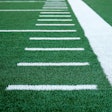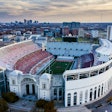Making Playgrounds Safer, Circa 2003

There's no question that the nation's playgrounds have become safer during the past decade. In 1992, 31 percent of the playgrounds inspected by the Consumer Federation of America (CFA) and the U.S. Public Interest Research Group (PIRG) were surfaced with cement, packed dirt or asphalt. Last year, that number had fallen to 4.5 percent.
But other news in the 2002 report, titled "Playing It Safe: The Sixth Nationwide Safety Survey of Public Playgrounds," wasn't so encouraging. Of the 1,037 playgrounds inspected in 36 states and the District of Columbia, 75 percent of them still had inadequate surfacing - which is the leading cause of playground injuries each year.
What's more, 52 percent of all climbing equipment and 35 percent of all slides were more than six feet tall, according to the survey. Almost half of the playgrounds inspected had swing hazards and 14 percent of them used wood that may be pressure-treated and contain a carcinogen known as chromium copper arsenate.
Considering that information, it's not surprising that more than 150,000 preschool and elementary school children still visit emergency rooms every year after being injured on public playground equipment, according to the Consumer Product Safety Commission. Another 53,000 are injured using homemade equipment or equipment designed for home use. Between January 1990 and August 2000, the CPSC received reports of 147 playground-related deaths of children younger than 15.
"The CPSC has some voluntary guidelines, but unfortunately, we easily identified too many playgrounds that don't comply," says Rachel Weintraub, the CFA's assistant general counsel and co-author of the "Playing It Safe" study. "Parents working with local officials can be effective advocates for safer playgrounds."
Enter the National Program for Playground Safety, a nonprofit organization established at the University of Northern Iowa in 1995 with a grant from the U.S. Centers for Disease Control and Prevention. The group's latest efforts include two awareness campaigns - one aimed at increasing adult supervision on playgrounds and the other targeting old-fashioned monkey bars and swings shaped like animals.
According to Donna Thompson, director of the NPPS, 40 percent of all playground injuries happen on playgrounds where there is a lack of or inappropriate adult supervision. The NPPS hopes to blanket 200,000 child-care and school facilities across the country with the $149.95 S.A.F.E. Playground Supervision Kit, which consists of a manual, video and fanny pack that includes a checklist of the 10 steps to safer playgrounds. Thompson reports that parks and recreation departments around the country have expressed interest in the kit, too.
NPPS officials have garnered support from the International Play Equipment Manufacturers Association, whose members will offer new-equipment discounts to facility operators who remove old monkey bar sets (usually square or rectangular structures made of 1/2-inch round pipe with lots of space between bars) and animal swings with snouts known to have hit children in the head and caused concussions.
Both campaigns should be in full gear by the time National Playground Safety Week arrives April 21-25. Already, almost a third of all states have passed some form of legislation designed to protect children on playgrounds by mandating safety requirements for design, installation and maintenance of equipment. For example, a North Carolina law that requires all new playground equipment and surfaces in child-care facilities to conform to CPSC guidelines has reduced injuries at those facilities by 22 percent, according to last year's study by the University of North Carolina at Chapel Hill School of Public Health.
Behind the scenes, a group of researchers at ASTM International are also looking at ways to make the nation's playgrounds safer, focusing on testing methods for surfaces. "Different labs get different results when testing the same surfacing materials," says Martyn Shorten, managing partner of BioMechanica, a Portland, Ore.-based firm that researches,develops and tests sports equipment. Shorten also serves as head of the ASTM task group assigned to revise the F 1292 playground surface testing standard. Proposed changes include using the same procedure for field and laboratory tests, using a single type of impact missile, testing more areas of a given surface, and adding tests for wet and frozen surfaces.
The alterations in testing procedures, which Shorten expects to be in effect sometime in 2004, will impact how playgrounds are operated and maintained. "The new requirements will change the test scores that laboratories produce," Shorten says. "Some will increase and some will decrease. Surfaces are purchased based on their 'critical fall height,' which should be equal to or greater than the deck height of the play structure. With the new standard, some critical fall height ratings will change by more than a foot. Responsible operators will install surfacing that has a critical fall height at least one or two feet higher than the equipment, and they should not have a problem."
More information on playground surfaces, playground equipment and the latest NPPS initiatives is available at www.uni.edu/playground.




































